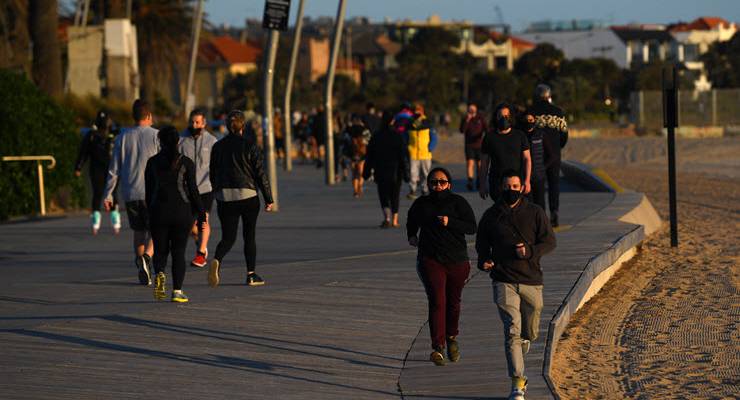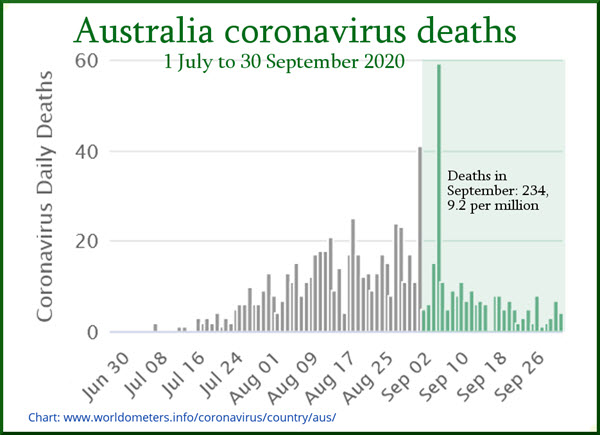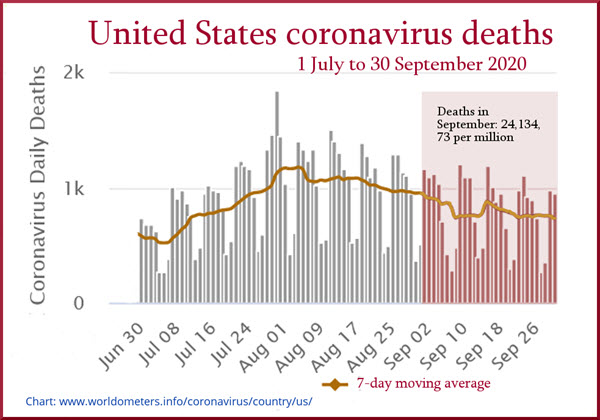
The world is gradually getting control of the COVID-19 pandemic. Without a vaccine.
Through the month of September, just ended, 23 countries recorded zero deaths. That’s up from 21 in August.
Another 29 nations recorded deaths at a rate lower than one per million inhabitants, and 28 others kept deaths below three per million.
Countries with the pandemic under control — if we take deaths below three per million as our benchmark — reached 80 in September. That’s up from 74 in August. Total deaths globally in September were 158,543, down from 173,778 in August.
So the world is definitely making progress, with some regions doing much better than others.
Europe
Most European nations bordering Italy which were devastated in March and April now have the virus controlled. Deaths per million in September were 7.8 in Switzerland, 6.8 in Italy, 5.5 in Ireland and just 2.4 in Germany. All of these copped deaths per million per month above 70 in April. Ireland and Italy were above 230.
Not all of Europe was so fortunate. France suffered badly in September with 1,321 deaths at twenty per million and Spain even worse with 2,697 deaths at 58 per million.
The Americas
The most glaring revelation from September’s data is that the Americas — North, South and Central — are now far and away the worst-hit part the world.
Total deaths worldwide in September were 158,543. Just six American nations — with 9.9% of the world’s population — accounted for more than half of these.
They were the USA (24,134 deaths), Brazil (22,581), Mexico (13,005), Argentina (8,439), Colombia (6,634) and Ecuador (4,799). Of the 16 countries with the most deaths per million, 13 were in the Americas.
Data reliability
The best information we have available is from Worldometers, which each day updatestotal infections, active cases, deaths, recoveries and tests completed. The data there is, of course, only as reliable as the agencies in each source country. We must accept that several nations cannot report infections and deaths accurately, including some which showed zero deaths in September.
These include poor African countries Burundi, Eritrea and Niger which have basic health facilities, and China which, with 1.44 billion people spread across 9.6 million square kilometres, seems unlikely to have had no deaths at all.
So for deeper analysis, we shall focus again — as we did here a month ago — on the 54 countries classified by the UN Development Program as very highly developed.
Leading nations worldwide
Of these advanced nations, the five which survived September without a coronavirus fatality were Estonia, Iceland and Luxembourg in Europe, and Singapore and Taiwan in Asia. Two kept deaths below one per million: Malaysia with nine deaths and New Zealand with three.
Other nations to keep deaths below three per million were Finland, Latvia, Cyprus, Norway, Lithuania, Germany and Slovakia in Europe, South Korea, Japan and Hong Kong in Asia and Uruguay in South America.
Worst outcomes among advanced nations
Only nine nations lost more than 30 citizens per million in September.
Those with deaths between 30 and 70 were Bulgaria, Bahrain, Oman, Spain, Romania and Israel.
Just three countries fared worse than 70 deaths per million: the USA (73), Chile (76) and Argentina (186).
Australia below the global median
The surge of infections and deaths in Victoria began in late July and peaked in early September on one disastrous day, September 4, when 59 deaths were recorded.
Fortunately the trajectory has been much more positive since. The seven-day moving average on September 30 was down to just four.

Australia recorded 234 deaths in September at a rate of 9.2 per million. That is much better than August’s 455 death tally at 17.8 per million, which was an average of 14.7 per day. Of the 54 highly developed countries, Australia ranked 29 th in September, just outside the top half.
The USA still lagging badly
The USA ranked 52nd out of the 54 advanced nations, with 23,134 deaths at a rate of 73 per million. Only Chile (1452 deaths at 76 per million) and Argentina (8439 deaths at 186 per million) had worse rates.

September confirms that most governments which are following the science, speaking the truth to their citizens and implementing appropriate preventative and remedial strategies are making progress. But not all. Random surges are still bedeviling several nations, despite their best efforts.
Those regimes not yet following the science, not being straight with their people and not implementing the recommended policies are experiencing serious and worsening outcomes.








Alan, thank you for this global picture. The domestic situation has been so volatile it’s easy to get focused on our own shoes. Yet a pandemic, like the global economy itself, is not managed one country at a time but by concerted multilateral action.
It really helps to periodically raise the periscope. I think yours was a concise, useful summary.
Would be interesting to match death rates not only against government response but also against the comparative underlying health of populations (say, by a comparison of diabetes incidence, obesity rates etc). Suspect it would add context to higher death rates in US and elsewhere.
A good summary. You do need to be a bit clearer that it is policies, luck/randomness, the environment and people’s behaviour. The second wave in the northern hemisphere which is now ramping up was well forecast and is mainly due the season (autumn-winter) and behaviour (indoors with other people). Merely correlating outcome to policy is misleading. Also it would have been good to see a summary of accumulated deaths per million, not just deaths per million in September, because I think that metric is in the final analysis the one that is most important. No mention of the disasters in Sweden, Belgium & the UK?
The figures you want are easily gleaned from Worldmeters and show that the Victorian outbreak has severely distorted the overall picture. At 35 deaths per million since the outbreak Australia comes out far ahead of virtually every other similar country. Equivalent figures for Canada 110, Denmark112, Germany 114.
Those latter countries are lauded as worlds best practice, and really it is only Singapore Taiwan, South Korea Japan Hong Kong Cuba and of course our beloved NZ 5 that are reporting better outcomes than our own. Other countries listed With better results than Oz have such poor health systems and administrations that any reported figures are highly dubious. China has done well on paper, but transparency and honesty on matters that would show the country in a negative light are not likely to be forthcoming.
Of course it would have been nice if Victoria’s blunders had not buggered up our remarkable success, but we can certainly hold our head high in world forums and with many other Western countries heading into second waves and Winter, and our own daily toll getting Better, our relative success will surely improve.
I really don’t think Australia has anything to ‘hold its head up high’ for. Initially our remoteness, comparatively low international travel flows, our less dense cities and the weather all contributed to a good outcome. The Federal government has been abysmal. Morrison delayed closing the international borders for Crown casino and his religious convention and it was only good luck it didn’t go pear shaped then….helped of-course by the season etc. the State and territory governments have, I admit, down reasonably well. Victoria I don’t think has been significantly different…their stuff-up unfortunately had dire consequences. I think for all the others it’s ‘there for the grace of god go I’. National cabinet is just COAG, meeting more frequently, and now, due to Morrison, in secret. It was just a typicalMorrison ‘announcement’ lacking substance. If there is going to be a test for Australia it will be the forecast second wave in May to August next year (it’s crap to call Victoria’s outbreak a second wave). Just look at the data for the Spanish flu……there are years of this stuff to come.
Canada wasn’t mentioned in the article.
Right bushby jane and there are interesting comparisons to be mage with insane asylum next door.
Leading nations worldwideOf these advanced nations, the five which survived September without a coronavirus fatality were Estonia, Iceland and Luxembourg in Europe, and Singapore and Taiwan in Asia. Two kept deaths below one per million: Malaysia with nine deaths and New Zealand with three.
Other nations to keep deaths below three per million were Finland, Latvia, Cyprus, Norway, Lithuania, Germany and Slovakia in Europe, South Korea, Japan and Hong Kong in Asia and Uruguay in South America.